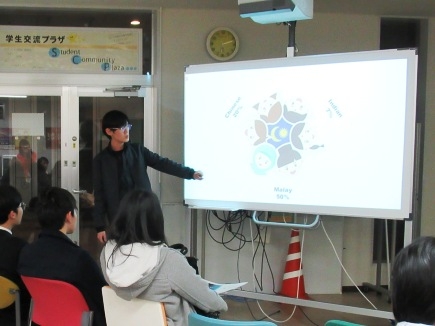HOME > 活動報告(2019年01月)
 活動報告(2019年01月)
活動報告(2019年01月)
南部 学生自主企画活動
International Day(1月15日)
- 日程
- 2019年1月15日(火)18:00~19:00
- 場所
- 長崎大学学生交流プラザ/Student Community Plaza, Nagasaki Univ.
- 内容
-
留学生が自国について、また、長大進学のために来崎してきた日本人学生が地元やふるさとについて簡単に紹介してくれる、GP恒例のイベント、International Day。今年度第3回目は1月15日(火)に開催しました!紹介してくれたのはマレーシアとレソトからの留学生。
マレーシアの留学生の話で印象的だったのは、同国には主にマレー系、中華系、インド系をはじめとして実に多種多様な人種、民族が共存しているため、例えばそれぞれのお正月が時期を違えて祝日として存在することです。各人種や民族ごとの祝日がマレーシアのホリデーになるので、年間の祝日日数は日本以上になることも。会場からは「いいなぁ」という声が上がりました。
また、マレーシアは人種や民族の数だけ言語が共存する多言語国家。プレゼンしてくれた留学生もマレー語、中国語、日本語、英語などを操るマルチリンガル!そして、あちらこちらに各宗派の建造物もあり、食文化や服装も様々に見られるのが特徴です。食べ物については、いくつかの文化やルーツがうまく混ざり合って現代に発展しているものもあるそうで、長崎のちゃんぽん文化と似ている!という印象を受けました。
続いてはレソトの留学生。「レソト」・・・?本当のところ、国名だと言われてもピンと来なかった人が多数。プレゼン冒頭から、「アフリカ大陸にある国。しかも南アフリカ共和国の中にある国」「独立して間もない若い国」「日本と同じように四季がある国」「国全土が標高1400メートルを下らない高地にあるので、アフリカなのに冬には雪が降る国」という事実に、参加者みんな驚きの連続でした。
高地という地理的特色を生かして世界的にも有数の大きさのダムを多数抱える同国は、南アフリカ共和国に水を供給する役割を担っており、小さく若い国でありながら、南アフリカ共和国の生命線を握っているという重要性や、海がない中で魚の養殖を行い、日本や中国、ヨーロッパに羊毛を輸出して発展しているという力強さを、たくさんの写真やグラフとともに紹介してくれました。
ひととおりプレゼンが終わった後、参加者からは言語について質問が飛び、同国ではソト語と英語が公用語として使われているけれど、土着の言語も多数話されているという話がありました。また、ソト語はいくつかの地域と民族によって数種類にわけられ、一つは、レソトを囲む南アフリカ共和国のある地域と隣接するボツワナでも使われていたり、もう一種類のソト語はスワジランドでも通用するという説明があり、島国に生まれたときから住んでいる日本人にとっては複雑怪奇でありながら大変興味深い発見で、しばし盛り上がりました。
前回同様、発表してくれた留学生はどちらも自国や故郷の町を誇りに思い、みんなに知ってほしい、一度訪れて欲しいという自国・郷土愛いっぱいのプレゼンをしてくれました。
お二人ともTerima kasih!Kea Leboha !(ありがとう!in Malay and Sesotho. )
また次回もお楽しみに!
“International Day” is one of popular programs which Nagasaki “Glocal” Alliance Project (GP) regularly has. At this event, Japanese and exchange (international) students introduce their home countries or towns for a few minutes. Presentation style is all up to each presenter! Either way, this event always makes the audience students to feel like experiencing a virtual tour to various places around the world and across Japan!
“International Day” for the third time in the school year 2018 was held in January. Exchange students from Malaysia and Lesotho volunteered to be presenters!
First came the presentation about Malaysia. It goes without saying that Malaysia is well known for its multiracial society, with many different ethnic groups living there, consisting mainly of Malays, Chinese, Indians and other indigenous groups. Still, it’s interesting to know there are lots of religious and cultural celebrations designated as national holidays including state or ethnic-specific ones according to the diversity of religious sects and racial groups. Malaysia is said to be the country with more public holidays than Japan!
Same here for languages. Malaysia, being exposed to a variety of culture and traditions, is a linguistically diverse country. Actually, the Malaysian male student presenter is a multilingual who speaks 5-6 languages including Japanese! Besides languages, how about historic constructions and styles of clothing? Yes, they’re all diverse and you must hit and see every kinds of them here and there in the country. Finally, he wrapped up his presentation with his favorite topic: cuisine. He said you can experience diversity in the perspective of food as well. Each indigenous culinary art and food culture has been cherished and carried on for many years, of course, but interestingly, some local cuisines have been combined to the best and tasty ones which is one of today’s symbolic food in Malaysia.
Next followed the presenter from Lesotho! Lesotho?? To be honest, it was the first time for many of the audience to learn the ABC of Kingdom of Lesotho. Every one of key facts of Lesotho which the male student from the country wowed the whole venue. How many of you have known the facts as below;
-Lesotho is completely surrounded by South Africa.
-It got her independence in 1966.
-It has four seasons as well as Japan and snows in winter because of its geographical features (mountainous and high-altitude!).
He showed a lot of graphs and illustrative images to reveal that Lesotho holds many dams and plays a crucial role to supply water to surrounding countries, mainly South Africa. Plus, he highlighted its high-speed growing economy and agriculture. Amazingly knowing that Japan is one of the largest export nations regarding its wool and mohair. Without a doubt, his presentation made us clear that Lesotho is rich in many attractive and beautiful spots which may put other famous highlands resort countries such as Switzerland to shame. While being a small and historically-young country, we definitely keep paying attention to it and this presenter himself is the real evidence. GP is honored to have this remarkable student from Lesotho!
After moved on to Q&A session, languages of Lesotho were asked from the audience and the student presenter explained that two official languages, English and Sesotho, are spoken but many other minority languages are spoken as well. Moreover, it picked our curiosity so much in that Sesotho is, strictly speaking, classified into mainly 2 kinds and their linguistic mosaics have been critically confirmed in the southern part of Africa. For us, especially Japanese of the unique ethnically and culturally homogeneous nation, this opportunity to encounter linguistic geography of Africa has been always challenging.
Both presenters ended up their presentations with remarks, “please come visit my country/town!” Seeing is believing. Their presentations have driven the audience to travel there to try many things from peculiar to staple ones!
See you next time!!






